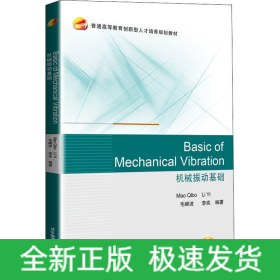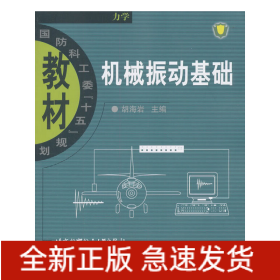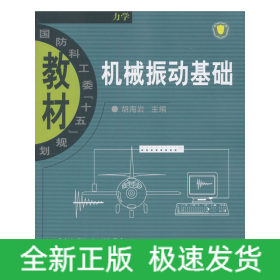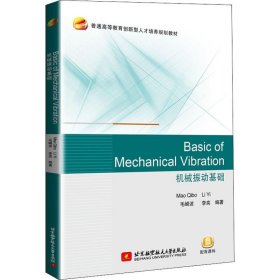
机械振动基础
全新正版 极速发货
¥ 14.37 2.9折 ¥ 49 全新
库存3件
广东广州
认证卖家担保交易快速发货售后保障
作者毛崎波,李奕
出版社北京航空航天大学出版社
ISBN9787512431492
出版时间2020-01
装帧平装
开本16开
定价49元
货号1202040627
上书时间2024-12-03
- 最新上架
商品详情
- 品相描述:全新
- 商品描述
-
目录
Chapter 1 Introduction 1
1.1 Background 1
1.2 Study of Vibration 3
1.3 Basic Concepts of Vibration 6
1.3.1 Degrees of freedom 7
1.3.2 Newton?s laws 8
1.3.3 Vibration classification 8
1.4 Organization of the Book 9
Questions 10
Chapter 2 Free Vibration of Single-Degree-Of-Freedom(SDOF) Systems 11
2.1 The Basic Mechanical Components 11
2.2 Free Vibration of UndampedSystems 12
2.2.1 Modelling of undamped SDOF systems 12
2.2.2 Simple harmonic motion 15
2.2.3 MATLAB examples 15
2.2.4 Solution for undamped SDOF systems 18
2.3 Rotary Systems 20
2.4 Springs Connected in Series or in Parallel 22
2.5 Modelling Using Energy Method 23
2.6 Viscously Damped SDOF Systems 29
2.6.1 Case 1: Overdamped motion (ζ> 1) 31
2.6.2 Case 2: Underdamped motion (ζ< 1) 33
2.6.3 Case 3: Critically damped motion (ζ=1) 34
2.7 Evaluating Damping Ratio from Measurements (Logarithmic Decrement) 36
2.8 Summary: the Effects of Damping on an Unforced Mass-spring System 39
2.9 MATLAB Examples for Free Vibration of SDOF Systems 39
2.9.1 Free vibration for undamped SDOF systems 39
2.9.2 Free vibration for underdamped SDOF systems 40
2.9.3 Free vibration for critical damped SDOF systems 42
2.9.4 Free vibration for overdamped SDOF systems 43
2.9.5 The GUI program for free vibration of SDOF system 44
Questions 45
Chapter 3 Harmonic Excitation of SDOF Systems 50
3.1 Harmonic Excitation 50
3.2 Complex Analysis 53
3.3 Undamped SDOF System with Harmonic Excitation 54
3.3.1 Excitation frequency ≠ natural frequency 54
3.3.2 Excitation frequency=natural frequency (resonant condition) 56
3.3.3 Response ratio for undamped SDOF system 57
3.4 Damped SDOF System with Harmonic Excitation 59
3.4.1 Response for damped SDOF system with harmonic excitation 59
3.4.2 Dynamic magnification factor for damped SDOF system 60
3.4.3 Response ratio for β=1 63
3.5 Harmonic Base Excitation 65
3.5.1 Relative motion 66
3.5.2 Absolute motion 67
3.6 Transmissibility of Vibration 73
3.6.1 Motion transmissibility 74
3.6.2 Force transmissibility 75
3.7 Rotating Unbalance 77
3.8 MATLAB Examples for Forced SDOF System 81
3.8.1 Harmonic excitation of undamped SDOF systems 81
3.8.2 Rotating unbalance vibration of SDOF systems 83
Questions 85
Chapter 4 Vibration of SDOF Systems under General Excitation 92
4.1 The Impulse Response 92
4.2 The Principle of Superposition 95
4.3 Response of SDOF Systems under a General Periodic Force 97
4.4 System?s Response to General Excitation by Convolution 104
4.5 System?s Response to General Excitation by the Laplace Transform 108
4.6 The Transfer Function 112
4.7 Composite Function Excitation 113
Questions 116
Chapter 5 Vibration of Multiple-Degree-Of-Freedom (MDOF) Systems 119
5.1 Free Vibration of Structures with Two-Degree-of-Freedom 119
5.1.1 Equations of motion for free vibration of two-degree-of-freedom 120
5.1.2 Free vibration analysis 121
5.1.3 Free vibration responses 124
5.2 Modelling of a System with n Degrees of Freedom 125
5.2.1 Governing equations 125
5.2.2 Coordinate coupling 130
5.3 Influence Coefficient Method 133
5.3.1 The stiffness influence coefficients 134
5.3.2 Flexibility influence coefficients 136
5.4 The Lagrange?sEquation 137
5.4.1 Derivation of Lagrange?s equations in Cartesian coordinates 138
5.4.2 Extension to general coordinate systems 140
5.4.3 Application of Lagrange?sequation 140
5.5 Solving the Equations of Motion of Undamped Systems UsingMATLAB 144
5.6 Vibration of Undamped MDOF System 148
5.6.1 Free response of undamped MDOF systems 148
5.6.2 Harmonic excitation of undampedsystems 156
5.7 Vibration of Underdamped MDOF Systems 158
5.7.1 Free vibration of underdamped MDOF systems 158
5.7.2 Steady-state forced vibration response for MDOF systems 162
5.8 The Dynamic Vibration Absorber 166
Questions 169
Chapter 6 Vibration of Continuous Systems 175
6.1 Transverse Vibration of Cables 175
6.2 Transverse Vibration of Beams 181
6.2.1 The governing equation of motion for beams 181
6.2.2 The natural frequencies and mode shapes for beams 183
6.2.3 MATLAB examples 186
6.3 The Structural Modes for Plates 190
Questions 193
Appendix A Mathematical Background 195
A.1 Mathematical Relations 195
A.2 Ordinary Differential Equations (ODE) 195
Appendix B Basic of MATLAB 199
B.1 How to Read this MATLAB Tutorial 199
B.2 Making Matrix 200
B.2.1 The colon operator 201
B.2.2 Matrix manipulations 202
B.2.3 The end keyword 203
B.2.4 Transposing a matrix 203
B.2.5 Element-wise operations 204
B.3 Functions 205
B.4 Graphics and Plotting 205
B.5 Programming in MATLAB 208
B.5.1 The M-files 208
B.5.2 Repeating with “for” loops 208
B.5.3 “if” statements 209
B.5.4 Writing function subroutines 210
B.6 Saving and Loading 210
B.7 The Help Menu 211
B.8 Set the Display Format for Output 212
B.9 Closing Remarks and References 212
Appendix C Properties of Laplace Transform and Laplace Transform Pairs 214
Appendix D Technical Terms 216
References 228
内容摘要
该书为英文版《机械振动基础》,主要讲述机械振动的基本理论。全书共分为六章,包括绪论、单自由度系统的自由振动、单自由度系统的简谐受迫振动、单自由度系统的任意受迫振动、多自由度系统的振动、连续系统振动,并包括"数学基础"、"MATLAB基础"、"Laplace变换"等。
相关推荐
— 没有更多了 —





















以下为对购买帮助不大的评价